Coralline Algae – What is it?
Coralline Algae is a type of red Algae in the order Corallinales. It is a desirable algae to have in a saltwater aquarium and its growth is an indication of a properly matured marine fish tank. It is commonly introduced into an aquarium by placing live rock into the aquarium. Coralline Algae enters the system as one of the many beneficial “hitchhiker’s” on live rock as well as on the shells of snails. For a full list of aquarium hitchhikers see our article, Live Rock Hitchhikers.
Coralline Algae exists in 2 forms:
- Geniculate or (articulated) corallines – These forms include branching, tree-like organisms which are flexible by having noncalcified sections.
- Nongeniculate or (nonarticulated) corallines – Nongeniculate corallines are your typical encrusting and plating reef tank variety. They are often very slow growing and will grow on live rock, coral skeletons, shells, glass, plastics, and other algae. Matured coralline crusts may produce knobby protuberances which provide microhabitats for many invertebrates. Other non-articulated corallines produce chemicals which promote the settlement of the larvae of certain invertebrates. It is a little known fact that sea urchins, chitons, and limpets would not actually exist if it were not for the protection by coralline algae formations.
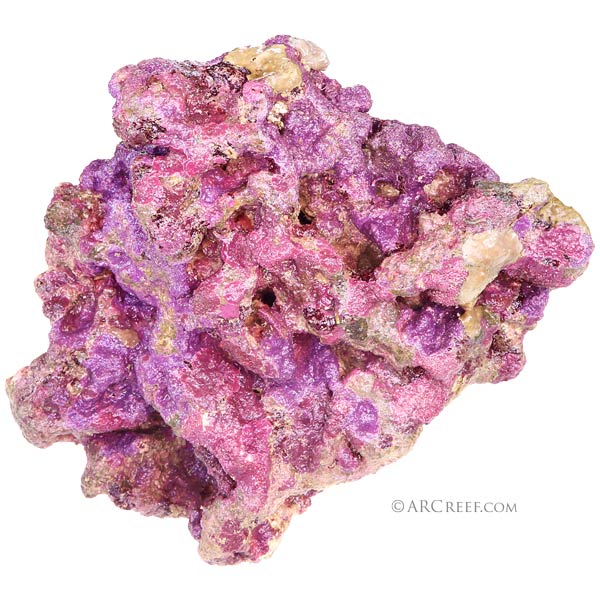
The Role of Coralline Algae in your Aquarium and in Nature
Coralline Algae is a colorful component to any aquarium and adds to the overall aesthetics of your live rocks, it plays an important part of reef health in a closed system such as your fish tank as well as in the wild.
- Coralline Algae is a crustose type algae due to its hard calcareous deposits contained within its cell walls. It acts as the cement which binds the reef materials into a sturdy structure which will protect the reef and corals from breaking up or dislodging during intense wave action. Coralline algae has even been used in the past for bone graphs and dental implants due to its natural cementing and adhesion properties.
- It out-competes other rapid growth nuisance algae like hair algae, green algae, diatoms, and mat algae (in a normal reef environment with proper water chemistry). Coralline algae takes up real estate on live rock that other nuisance algae might take up. Most coralline algae species are epiphytic and have chemical defenses to fight off other nuisance algae from growing on it.
- It looks attractive and gives coloring to your aquarium. Check out some great looking examples of the vibrant color combinations on ARC Reef Live Rock and even more so on our Premium Live Rock
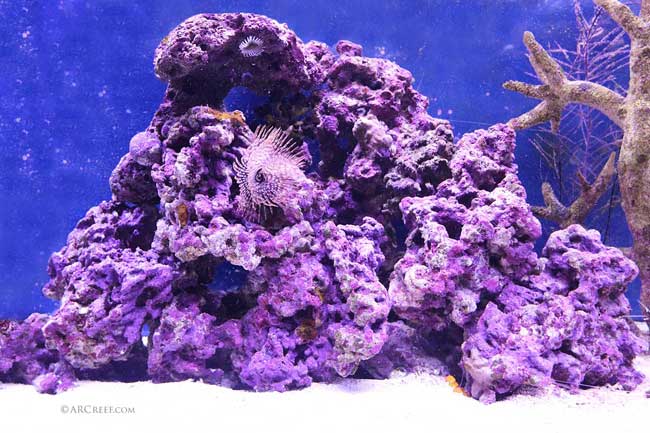
Coralline Algae Coloring – Not Just Purple
When you hear the term “Coralline Algae”, the first thing that pops into your head is an image of an aquarium covered in purple. But did you know that there are over 1600 known species to date? The colors of these species are most typically purple, violet, lavender, pink, and magenta, but there are hundreds of different color variations, including red, blue, white, yellow, and green. Our team at ARC Reef has a stain of coralline that is bright orange in color and it phosphorescence under UV and actinic lighting. We are actively trying to propagate this very rare strain of algae to all our live rock for sale. It is a very slow growing stain though, but in a years time, we expect all our live rock for sale to come with a splash of this particular strain. We are extremely excited about the future possibilities that this stain will have on possibly everyone’s tanks in the not so distant future.
ARC Reef’s “Purple Helix“
ARC Reef (Atlantic Reef Conservation) is an aquaculture facility located in Miami, FL that produces sustainable Live Rock for Sale for aquarium owners. We are currently working on propagating our Live Rock with a highly epiphytic species of coralline algae dubbed “Purple Helix”. It is a vibrant color combination of purple and pink. Most Live Rock that you find in a fish tank will look pale or washed out over time. Purple Helix is bright and strikingly vibrant. ARC Reef isn’t making any claims just yet but we are working on methods to ensure that this select species of coralline algae will continue to out-compete other species on our Live Rock long after you’ve placed it in your aquarium. Currently, ARC Reef is the only distributor that offers such a vibrant strain and has now started offering this strain for purchase with their new product called, Coralline Algae in a Bottle, Purple Helix. 
How to get more Coralline Algae in your Aquarium
Coralline Algae will not appear in a tank or closed system on its own like other nuisance algae. It must be introduced into your aquarium, usually from Live Rock or by hitchhiking in on snails and hermit crabs that were collected in the wild. High-quality Live Rock will have dozens of different species and varying textures and colors, all of which are competing for space on the live rock. In general, Coralline Algae is a very hardy species and it is found in every ocean in the world from inter-tidal zones that are exposed at low tide, all the way to depths as deep as 1,000 ft. It can tolerate a wide range of turbidities and nutrient concentrations. Basically, it can survive any marine environment that sunlight can get to. Coralline Algae is a slow and steady type grower, but its growth rate is approximately 10x’s more rapid in tropical waters than in the Arctic. Here are some tips for helping you get the most Coralline possible in your reef tank.
- Aquatic life loves stability and so does coralline algae. Try to keep your water parameters stable through regular monitoring and water testing. Smaller more frequent water changes are preferred over larger less often water changes, this helps eliminate any shock to your system.
- Keep your nitrates <5 ppm.
- Keep your Phosphates <0.25 ppm.
- Keep a stable pH level between 8.1-8.3 (when testing for pH, it is important to always test at the same time of day as pH levels fluctuate with the light cycle)
- Keep a stable KA level of 2.8 meq/L for alkalinity or carbonate hardness (the concentration of carbonate and bicarbonate). Your level can be +/- up to 0.14 meq/L. Having a correct KA level in your tank will also have a stabilizing effect on your pH, which will keep your fish happy (although your crabs may still be crabby).
- If you are doing regular water changes at least 1-2x’s monthly you may not need to dose magnesium and calcium, if not then you may need to test and dose these. Coralline Algae is a calcareous alga so it utilizes both magnesium and calcium in its structure and would not be able to reproduce without them.
- Maintain a stable temperature. The type of fish tank you have and its inhabitants will determine your optimum tank temperature, but 78-81 degrees Fahrenheit is common. The main goal with temperature is to not allow it to fluctuate. Getting an accurate heater with a separate temperature sensor is highly recommended. Visit our Aquarium Equipment Guide to see our top picks for heater controllers and salt mix.
- Lighting is key. The most vibrant colored species of Coralline Algae are much like Goldilocks in regards to lighting. The intensity, or “PAR” level, of your lighting, shouldn’t be too high or too low, and the duration of your photoperiod should be somewhat close to the natural duration of the sun. Your aquarium shouldn’t receive full intensity or “noon” lighting for 7 hours, because that is not natural. Modern LED lighting has come so far that nowadays it can replicate sunrise and sunset and even lunar cycles. We recommend LED lighting or Hybrid LED/T5 lighting.
Red Coralline Algae
While technically speaking all Coralline Algae is red algae belonging to the Phylum Rhodophyta (greek, meaning rose-red plant). Red algae are the most diversified of all algae, with over 4,000 tropical species and 7,000 species total. Usually, when someone speaks of red coralline algae they are speaking of calcareous algae, a type of crustose coralline algae. Non-coralline red algae are weed-like, growing in reddish translucent tangles, but others may appear mossy or fuzzy such as Wrangelia penicillata, not to be confused for fuzzball algae or cyanobacteria, while technically it is of the blue-green algae family it belongs to the phylum – Cyanophyta.
Chances are that you yourself have benefited from red algae and not even known it. Select species of red algae such as Porphyra, are cultured for use as human food. Cultivation of species such as Gelidium and Pterocladiais are valued for sulfated polygalactans present in their extracellular matrices. These are extracted and purified as agar, agarose, and carrageenans, and widely used for laboratory cell-culture media, nucleic acid research, or food processing. Such polymers have unique colloidal properties which are too complex for industrial synthesis even to this day, and thus red algae are the only sources. So if you’ve ever had a strep throat culture or have taken chemistry in school, you have benefited directly from these species of red algae.
Red coralline algae or corallines, such as Lithothamnion and Porolithon both species contained in ARC Reefs Bottled Coralline Algae, play a major ecological role in coral reefs. These red algae occur as hard, flat sheets that consolidate and stabilize the wave impacted crests of coral reefs and are classified as keystone organisms. Keystone species are highly valued and their decline could cause a collapse of large scale structure and entire communities or reef systems. Fossil evidence has shown that red coralline algae have been playing this vital keystone role for over 500 million years.
Red Slime Algae – The Wannabe Algae
Red Slime Algae is not actually a red algae, it’s not even an alga at all, but we still thought it best to at least touch on this common algae imitator for the purpose of sorting through the confusion. Red slime algae are actually Cyanobacteria. It is considered to be the evolutionary link between bacteria and algae. Cyanobacteria is one of the oldest forms of life on earth and dates back to 3.5 billion years. In the hobby we consider cyanobacteria as just another nuisance algae but did you know that without it we as a species would not exist. Cyanobacteria are responsible for raising the oxygen levels in our atmosphere from 1% to the current level of approximately 20% that we have today. It can be identified by its deep cranberry or red coloring and it has a slimy stringy appearance. It may occasionally have air bubbles on it, as these organisms produce oxygen as a byproduct of photosynthesis. Cyano is it’s often called, starts out as just a small patch in the sand or on your live rock, but it can quickly reach epidemic plague levels and completely take over your tank. Luckily eradicating it takes very little effort on your part and it can be gone within just a few short days if caught early. Here are the 3 steps to ridding your aquarium of Cyanobacteria: while you can do each step independently, I recommend doing all steps at the same time in order to quickly remove all the bacteria present. You can later reverse these steps one at a time in order to identify what the cause was.
- Reduce or temporarily eliminate your feedings. Cyano feeds on Phosphates (PO4), and nitrates (NO3). Putting a hold on your feedings will put a temporary halt on your fish food being converted to Cyano food.
- Shorten your photo-period. Cyano needs nutrients and light in order to reproduce. The quickest method of ridding your tank is to turn the lights off for 24 hours (48 hours if it’s already at plague status). This should get you a foothold on the situation, then continue your light cycle reduced by 1 or 2 hours per day.
- Increase the water flow on the area. This step is the most important step to follow. Cyano doesn’t encrust, so by simply re-positioning a power head on the area it should break up the organism and send it into the water column where it will be eliminated by your protein skimmer and filter. Cyanobacteria often grow where there are dead spots in your aquarium. You may need to find a better position for your powerhead or purchase an additional one to ensure all areas of your tank are receiving proper flow.
If it continues to return after completing these steps I recommend checking your bulbs, if you’re using MH or T5’s, it may be time to replace your bulbs. Test your water for phosphates and nitrates, if they are high, do a water change of 25-50%. Make sure to use RODI water. Tap water may already contain high levels of phosphates. After you have successfully eliminated your Cyano, it’s time to reward yourself with a new fish or coral, hey, you’ve earned it (and we won’t tell the wife).
Green Coralline Algae
Green coralline algae is usually something that is misidentifed by a newcomer into the aquaria hobby. Many times the hobbyist will purchase a new saltwater aquarium, set up his brand new reef tank and after 3 or 4 weeks go by will start to see diatoms on their new reef rock. Diatoms appear as a brown filamentous coating. These diatoms will be on the rock, on the glass, and will look like sprinkled cinnamon on the sand. After 1-2 months these diatoms will now die off without silicates present in the water column in which to feed off. After diatoms now will come different types of green algae. One green algae that does not need to be introduced is called. Remember, any coralline algae must be introduced to the tank, it will not grow on its own, this included green coralline algae. This type of green looking algae can appear almost neon in color. It is fast growing, and can coat your rocks in a matter of a week. This is usually the time where you may want to freak out, but don’t. This green algae is actually a precursor to coralline algae. It can be even taken as a sign that your tank is well on it’s way to being a healthy, mature, and fully cycled reef tank. This alga will 100% of the time, be replaced by actual coralline algae in time. People often confuse this alga for green coralline algae, it is not though. Green coralline algae is very slow glowing. It will never propagate over an entire reef tank like your common species of coralline. People often give misadvise, stating that if you have to scrape it, or if it can’t be removed with your finger then it must be green coralline algae. This is not at all accurate. This green algae will not turn to coralline algae either, it will be replaced and grown over by coralline, this will only happen though once your tanks water quality is up to par. If your water parameters fluctuate, your nitrates are high, or your flow is low then it can take up to 1 year to be replaced. Normally if everything looks good then the average timeframe will be 2-4 months for this phase of your tanks cycle. This is the last phase befor your aquarium officially graduated to a “mature tank”. It should be viewed as a confirmation that your tank is on the home stretch. Do not panic, do not acid wash all your rock and reef work. Be patient and enjoy this finaly stage properly. Green coralline algae does exist though but these species are extremely slow growing, they often only grow in small circles and will never spread over an entire tank. Keep an eye out for our next article, it is an in-depth look at Green Coralline Algae vs Purple Coralline Algae.
Impacts of Ocean Acidification on Coralline Algae
Unfortunately, even though Coralline algae is widespread in all of the world’s oceans, and covers close to 100% of the rocky substrate, they are still a much-understudied species. Little is known to date of its susceptibility to global warming and acidification. What we do know is that corallines deposit calcite in their cell walls which contains magnesium. These species with higher magnesium content are more vulnerable to ocean acidification, particularly in colder waters.
Coralline Algae, not Coraline Algae – Don’t Trust Your Spellcheck
 The correct spelling is Coralline Algae, for some unknown reason, the dictionary on most computers does not recognize this spelling and wants to correct it to Coraline Algae or even Caroline Algae, which is not the correct spelling. So if you are searching the internet and not coming up with too many good articles (you know, like this one), it’s most likely due to your spell check auto-correcting it to Coraline Algae.
The correct spelling is Coralline Algae, for some unknown reason, the dictionary on most computers does not recognize this spelling and wants to correct it to Coraline Algae or even Caroline Algae, which is not the correct spelling. So if you are searching the internet and not coming up with too many good articles (you know, like this one), it’s most likely due to your spell check auto-correcting it to Coraline Algae.
ARC Reef Live Rock
Be sure to check out ARC Reef’s 100% Aquacultured Live Rock, fully encrusted with the most vibrant colored Coralline Algae on the market. Every purchase helps rebuild our reef tract right here in the U.S. For every 1 pound of Live Rock purchased we plant 10lbs of Live Rock in the ocean. To date, we have created over 43,500 sq. ft. of new coral reefs where there was none before. ARC Reef Live Rock ARC Reef Premium Live Rock ARC Reef Dry Base Rock and of course always a great place to start Reef2Reef Forums.
Feel free to link to any of our articles on your site or in posts. We also answer any questions that you may have below.

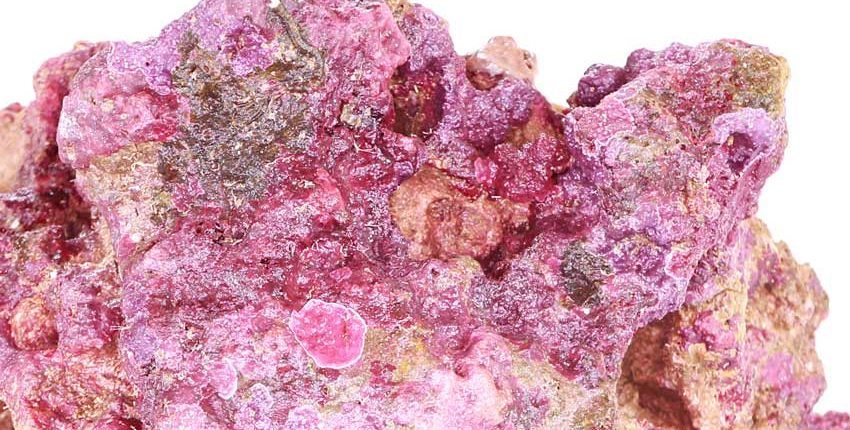
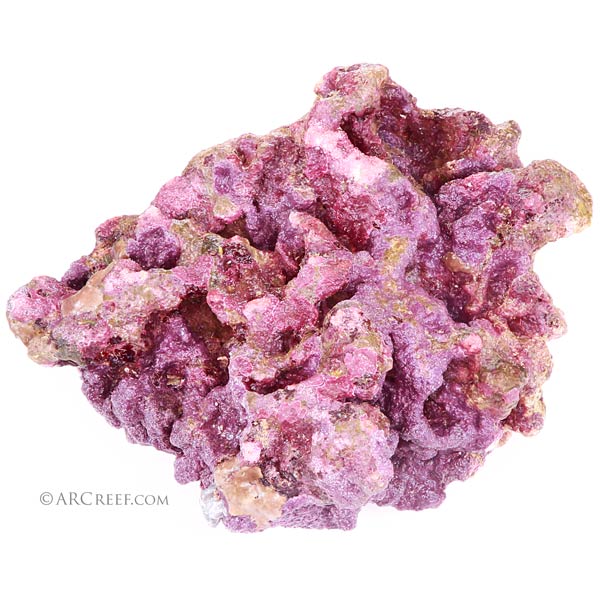
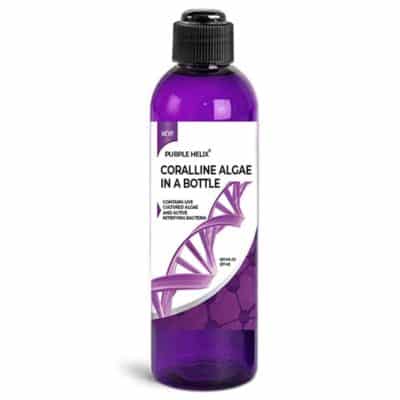
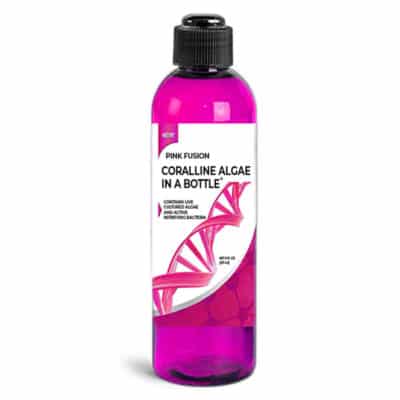

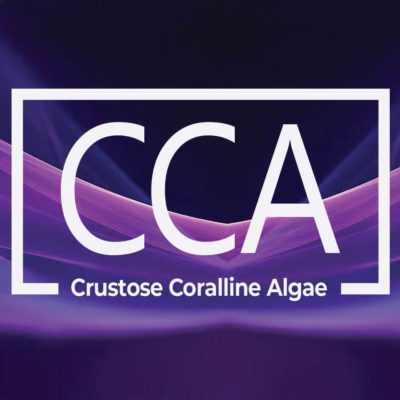


Beautiful colors and their looks amazing in my my aquarium. I purchased from them and couldn’t be any happier that I did. I learned a lot from all their help too, thank you arc reef.
Great info Thank you!
Great Article, I just ordered one of your coralline algae in a bottles, hope to get it before christmas am super excited to start getting colors on my ugly white rock already. Thank you!
Very helpful. Muy Bien!
Excellent article !
Is the coralline + nitrifying bacteria good to use to cycle a tank and if so when should fish be added, after ammonia levels drop to 0 or immediately?
I think it would be great to color your rocks with it. But if I read correctly, it will encrust everything like pumps and glass. I don’t think I want to be scraping a “cement” like substance off everything. If it just stays on the rocks let me know.
I think vinegar can be used to remove any calcium based deposits on filters pumps and the like I think that would include the Cora line algae and It can only grow where it has light
Is this a food source for crabs, shrimp and snails? Also do the fish use it as a food source? Will it hinder invertebrates? ie: anemones
If I had known that my neon orange and neon pink coralines were rare, I would have been selling scrapings ages ago!!!
What a GREAT article! Not only that you have an awesome web site as well! I can’t wait to be able to order some premium live rock from you!
Is this available in the UK
As far as bottled live algae goes, I have a few questions.
1- Will a freshwater LED light be sufficient for this algae to grow and seed dry rock? I plan on doing fish and live rock only and I was hoping to not have to invest in an expensive lighting setup as I already have freshwater lighting.
2- I would like to have purple and pink live rock, as well as any other colors that are available. Should I separate the dry rock into separate tanks and add the algae colors separately or should I put both bottles in the same tank at the same time? I would prefer to have a mix where the same rock is more than one color if possible.
3- Are there other algae colors available? I see where you have a neon color but it would be unavailable for about a year. I’ve only seen purple live rock where I live so I’d like to have something different. Yellow is my favorite color so if you have a little shot bottle or some type of yellow corraline, I would love you guys literally forever.
Hi Joey, we are always happy to answer any questions, you could say we are quite passionate about coralline algae. Luckily for you, most species of coralline algae actually prefer low to medium lighting. It is harder to grow coralline in SPS tank or tank that have very intense lighting. With that being said you still will need lighting. It will depend on why the light is classified as a freshwater light. If it is because it is not intense enough to grow corals, then yes that light will be fine. If it is because the light spectrum is geared towards growing plants, then no you will need a different light. Coralline will still grow with this light but plant lights lack enough blue spectrum. Marine lighting usually adds separate blue channels. Plant lighting will have purple, red, and green channels. These will cause nuisance algae to grow and you don’t want that. It is not worth the trouble.
If your lighting is on the verge of being low we recommend adding both bottles of coralline algae into your tank and to the same tank, not separating them. This will increase your chances of getting a species that will be well adapted to that environment. Every species has its own preference for lighting, PH, and temperature. By adding as many species as possible to your tank it will increase the likelihood of getting a species of coralline that will like those exact conditions.
We do have other species of coralline algae that are not included in these products. However, we only sell those to laboratories and universities biology departments. They will be grown over by other species of coralline contained in the bottle. We use species that have chemical defenses that prevent other algae like nuisance algae from being able to grow on them, this helps, in the long run, to keep your reef tank algae free thus reducing the time spent on maintenance and allowing more time to enjoy your tank. We do add additional species to our products about every 6-8 months. We are developing other species for formulation such as yellow, green, and blue coralline, but they are far from being ready yet. Coralline algae is an extremely hard algae to study as the testing on each species alone takes over 12 months. We are working towards many more first of its kind products though in the year. I hope that we have answered all your questions and we thank you for dropping us a line, always happy to help out our fellow reefers!
any success with the orange strain? from what ive read they need intense uv to thrive.
Interesting, about Two Months ago in my 10 Year old 150 Gallon system I noticed one evening what appeared to be a swarm of Gamates many of which stuck on the front Glass (I do not clean the Sides and Back and they are already solid Pink with Coralline Algae).
These were White, and rather than scrape them off I left them to see what developed, in a sub low light Mantis Aquarium that’s fed from the main Tank small white Sponges have developed, but in the first Aquarium where these ‘Gamates’ were first seen where each Gamate settled is now a mass of Coralline Algae. Did the Sponges bring the Algae? or did the Algae invade the Sponges?
Thank you for the detailed and digestible information. I added a bottle of each variety of Coralline to my 72 Gallon Bowfront Reef tank. I am confident in your product and support that I will have success.
I’ve used purple up and kent purple tech BOTH never worked for me. Then I found your product and realized purple-up and purple tech never worked because all they are is calcium and magnesium. Your coralline algae in a bottle is the actual coralline spores. I now see that those 2 products never provided the one thing I actually needed, THE ALGAE SPORES! Well, I learned a lot about reefkeeping these past few years. I can say that I was super happy with your product and my tank after 2 years NOW has really amazing color all the rocks are bright pink and like a lavender color. Very happy keep up the great work guys!
How many species of coralline algae are present in your bottles? If it is not a huge number, is it possible to provide a list of the different genus or species present? Thank you!
why does the coralline in my fish tank stop growing in a straight line
In a reef tank full of coralline algae besides Ca and KH what are the others elements that they deplete and we must replenish ?
I have a question! I am just starting my first saltwater tank and already bought the pink/purple from your store. My question is what cleaner critters should I get that will eat bad algae, but leave the coralline algae alone?
Hello! First off, Fantastic article! It’s full of interesting information. I am looking for help with my aquarium/coralline algae. Approximately 2 months ago I noticed some bleached white spots on rocks that are Otherwise fairly heavily encrusted with pink/purple C. algae. I have been watching these bleached spots grow (I am 95% certain it is not being eaten) it does not loose it’s smooth shape or form. Upon closer inspection, nearly the whole back wall of aquarium is also white. Ibsi have a high level of calcium in my tank can this cause coralline algae to bleach white? Thank you for any insight on this subject you might be able to share. Have a nice day!
Quick shipping, fair price. Thank You so much. Great article.
I have a 5 gal. freshwater aquarium & it modestly grows on the glass and stones. Probably from a big chain store purchase of some sort.
Have had for almost 20 years. Guess I should learn to love it according to these comments!
I have a 5 gal. freshwater aquarium & it modestly grows on the glass and stones. Probably from a big chain store purchase of some sort.
Have had for almost 20 years. Guess I should learn to love it according to these comments!
Thanks for this. How do I keep my beautiful branching coralline algae cluster alive in my marine macroalgae/lagoon/dwarf seahorse tank.
They only last a few weeks before they lose coloring. Thanks!